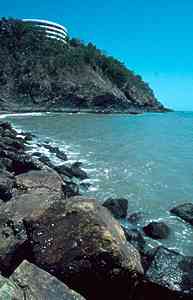|
|
Wave
Strength, Aspect and Battering
Environmental
Factors
Overview:
Water is not static. Every rock surface, sandy shore and mud shore is affected by the seawater that surges against it. Sometimes this may be a gentle surge but at other times rocks and beach are pounded by storm waves.
Boulders:
The creatures on the surface of a boulder facing the battering waves have a much rougher time than those on the rear, in the wave shadow. This determines the type of species found on an individual boulder or rock face.
Surf barnacles, such as the Rose-coloured Barnacles, Tesseropora rosea, and Giant Rock Barnacles, Balanus nigrescens, occur on the ocean face, while other barnacles such as the Rosette Barnacle, Tetraclitella purpurascens, prefer a more protected habitat at the rear of and underneath the boulder.
The numerous Honeycomb Barnacles, Chamaesipho tasmanica, and the Six-plated Barnacle, Chthamalus antennatus are often found high on rocks at about high tide level, where they are often baked by the sun.
Interestingly, many species prefer living on an ocean face in regions of smashing water and swift currents because this is where there is abundant planktonic and detritus food.
High on the Shore:
Spray and mist from strong waves can moisten rock surfaces far above the highest tide levels. Littorina and Nodilittorina species are found here.
Southern Australia:
From Fraser Island, south-eastern Queensland, around Australia's southern shores to Shark Bay in central Western Australia, the coast is subjected to high-energy waves from the mid-latitude storm belt of the Southern Ocean and the Tasman Sea (40 deg. - 60 deg. South). Here there are no tidal flats on the open ocean shore. Mudflats form only in estuaries and sheltered inlets protected from the ocean swell.
Northern Australia:
 In
the tropics, wave energy is low, except for occasional cyclones. Central
and north-eastern Queensland coasts are sheltered by the Great Barrier
Reef.
In
the tropics, wave energy is low, except for occasional cyclones. Central
and north-eastern Queensland coasts are sheltered by the Great Barrier
Reef.
Freshwater rivers bring down silt from eroding farmlands, especially during the annual monsoon season. Fine sediment is not washed out to sea, so most coastlines and creatures are covered with a layer of mud. Creatures that live along the Queensland coast on the rocky shores are dull and plain in colour compared to their colourful relations on the Great Barrier Reef, sometimes only tens of kilometres away.
This is Yorkey's Knob, just north of Cairns in Tropical Queensland.
In the tropics, shores extend out from a low-lying mainland, with virtually no cliffs. The shoreline is most unlike southern sandy and rocky shores. There is a succession of sandy, shell-grit and coral-rubble beaches, mudflats and mangroves. Mangrove forests are important here.
There are a few rocky reefs and low outcrops of weathered sandstone beach rock. Scattered boulders lie everywhere. Usually there is an extensive fringing reef. In tropical Australia the food chain is plankton- and detritus-driven, not algae-driven as along Australia's southern shores.
References
Bennett, I. (1987) W. J. Dakin's classic study: Australian Seashores. p. 3-12, Angus & Robertson, Sydney.
Davey, K. (1998) A Photographic Guide to Seashore Life of Australia. p.8, New Holland, Sydney.
Environmental
Factors
Latitude
Currents
Wind Effects
Wave Strength
Tidal Effects
Desiccation
Substrate
Turbidity
Salinity
Home
Page
Taxonomy
Biogeography
Rocky Shores
Tidal Levels
Intertidal Zonation
Environmental Factors
Biological
Factors
Feeding Relationships
Activities
Glossary
References
 Life
on Australian Seashores
Life
on Australian Seashores
by Keith Davey (C) 2000
Learning Consultant
- Media
The University of Newcastle
email at australian_seashores@hotmail.com
Scientific Consultant: Phil
Colman
site created 01.01.98 : updated 01.04.2000
